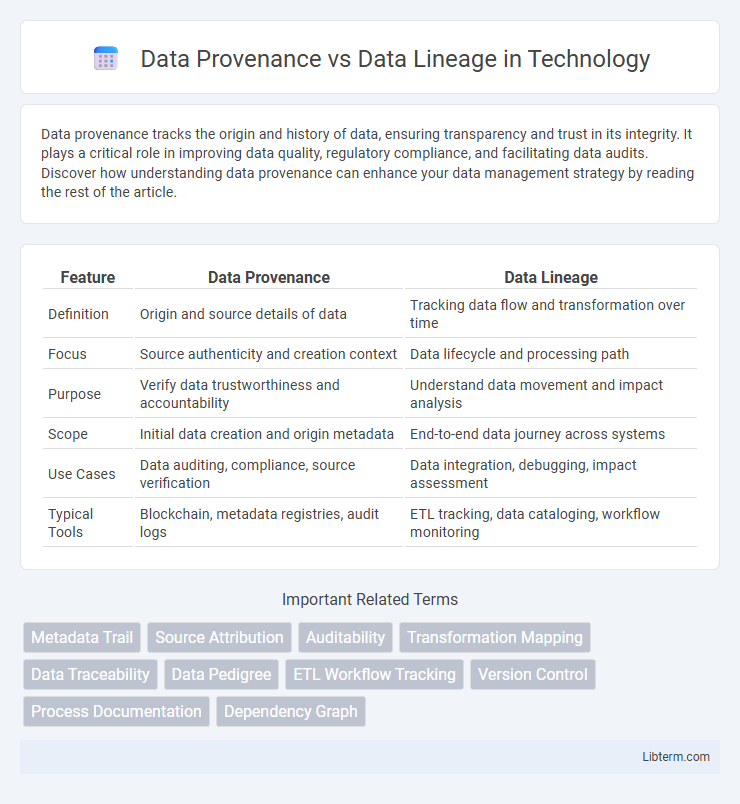Data provenance tracks the origin and history of data, ensuring transparency and trust in its integrity. It plays a critical role in improving data quality, regulatory compliance, and facilitating data audits. Discover how understanding data provenance can enhance your data management strategy by reading the rest of the article.
Table of Comparison
| Feature | Data Provenance | Data Lineage |
|---|---|---|
| Definition | Origin and source details of data | Tracking data flow and transformation over time |
| Focus | Source authenticity and creation context | Data lifecycle and processing path |
| Purpose | Verify data trustworthiness and accountability | Understand data movement and impact analysis |
| Scope | Initial data creation and origin metadata | End-to-end data journey across systems |
| Use Cases | Data auditing, compliance, source verification | Data integration, debugging, impact assessment |
| Typical Tools | Blockchain, metadata registries, audit logs | ETL tracking, data cataloging, workflow monitoring |
Introduction to Data Provenance and Data Lineage
Data Provenance refers to the detailed history of data origin, capturing the sources and transformations that data undergoes throughout its lifecycle. Data Lineage maps the flow of data from its origin through various processes, systems, and transformations, offering a visual representation of data movement and dependencies. Both concepts are essential for ensuring data integrity, compliance, and traceability within complex data environments.
Defining Data Provenance
Data provenance refers to the detailed record of the origins, history, and lifecycle of data, capturing where the data was created, how it has been transformed, and the processes involved in its generation. It emphasizes the source and authenticity of data, ensuring traceability back to its original form for verification and compliance purposes. Understanding data provenance supports data governance, quality assurance, and regulatory adherence by providing transparency into data creation and evolution.
Defining Data Lineage
Data lineage refers to the detailed tracking of data's origins, movements, transformations, and ultimate destinations through an entire data lifecycle within complex systems. It provides a comprehensive map illustrating how data flows across various processes, applications, and environments, enabling transparency and accountability in data management. Understanding data lineage is essential for impact analysis, regulatory compliance, and ensuring data integrity in enterprise data ecosystems.
Key Differences Between Data Provenance and Data Lineage
Data provenance details the origin, history, and transformations of data, tracing its creation and every modification at a granular level. Data lineage maps the flow and movement of data across systems, illustrating the path data takes from source to destination in a broader context. Key differences include data provenance's emphasis on the detailed history and authenticity of data, while data lineage focuses on understanding data flow, integration points, and impact analysis within data ecosystems.
Importance of Tracking Data Provenance
Tracking data provenance is crucial for ensuring data integrity, as it provides a detailed record of the origin, history, and transformation of data throughout its lifecycle. Accurate data provenance supports compliance with regulatory standards such as GDPR and HIPAA by maintaining transparent audit trails. Furthermore, it enhances data quality and trustworthiness by enabling organizations to identify errors, validate sources, and reproduce results efficiently.
Significance of Data Lineage in Data Management
Data lineage plays a crucial role in data management by providing a detailed map of data flow from its origin to its current state, enabling data provenance to track data's history and transformations. Precise data lineage ensures transparency, improves data quality, supports compliance with regulations such as GDPR and HIPAA, and aids in impact analysis during data changes. Enterprises leverage data lineage to enhance data governance, streamline troubleshooting, and maintain trust in analytics and business intelligence processes.
Use Cases for Data Provenance
Data provenance provides detailed records of data origin, transformations, and ownership, critical for regulatory compliance in finance and healthcare industries. It helps in forensic analysis to trace data errors back to their source, improving data quality and reliability. Data provenance supports audit trails and accountability, enabling organizations to verify data authenticity and maintain trust in data-driven decision-making.
Use Cases for Data Lineage
Data lineage provides a comprehensive visual map of data flow from its origin through transformations to its final destination, enabling organizations to track data movement for regulatory compliance, impact analysis, and troubleshooting. Key use cases for data lineage include validating data quality, ensuring governance in complex ETL processes, and supporting audit trails in industries like finance and healthcare. By maintaining clear data lineage, businesses enhance transparency, reduce errors, and accelerate root cause analysis during data-related incidents.
Challenges in Implementing Data Provenance and Lineage
Implementing data provenance and lineage faces challenges such as ensuring data accuracy and consistency across diverse sources and systems, which complicates tracking the complete history and transformations of data. Scalability issues arise when handling large volumes of data flowing through complex pipelines, requiring robust infrastructure and efficient metadata management. Privacy and security concerns also impede implementation, as sensitive information must be protected while maintaining transparent data traceability for compliance and auditing purposes.
Best Practices for Managing Data Provenance and Lineage
Effective management of data provenance and data lineage requires implementing robust metadata standards to ensure accurate tracking of data origin, transformations, and movement across systems. Utilizing automated data cataloging tools enhances transparency and facilitates compliance by capturing detailed lineage information in real-time. Regular audits combined with clear documentation improve data integrity and support regulatory requirements, enabling reliable analysis and decision-making processes.
Data Provenance Infographic

 libterm.com
libterm.com